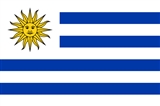
officially the Oriental Republic of Uruguay,
sometimes the Eastern Republic of Uruguay;
reˈpuβlika oɾjenˈtal del uɾuˈɣwai) is a country in the southeastern part of South America
. It is home to some 3.5 million people, of whom 1.8 million live in the capital Montevideo
and its metropolitan area
. An estimated 88% of the population are of European descent.
Uruguay's only land border is with Rio Grande do Sul
, Brazil
, to the north.
1807 A British military force, under Brigadier-General Sir Samuel Auchmuty captures the city of Montevideo, then part of the Spanish Empire now the capital of Uruguay.
1811 Battle of Las Piedras: The first great military triumph of the revolution of the Río de la Plata in Uruguay led by Jose Artigas.
1825 Uruguay declares its independence from Brazil.
1828 Uruguay is formally proclaimed independent at preliminary peace talks brokered by Great Britain between Brazil and Argentina during the Argentina-Brazil War.
1865 The Empire of Brazil, Argentina and Uruguay sign the Treaty of the Triple Alliance
1919 Uruguay becomes a signatory to the Buenos Aires copyright treaty.
1967 Uruguay becomes a member of the Berne Convention copyright treaty.
1973 The President of Uruguay dissolves Parliament and heads a coup d'état.
1977 The military-controlled Government of Uruguay announces that it will return the nation to civilian rule through general elections in 1981 for a President and Congress.
1991 Argentina, Brazil, Uruguay and Paraguay sign the Treaty of Asunción, establishing Mercosur, the South Common Market.

